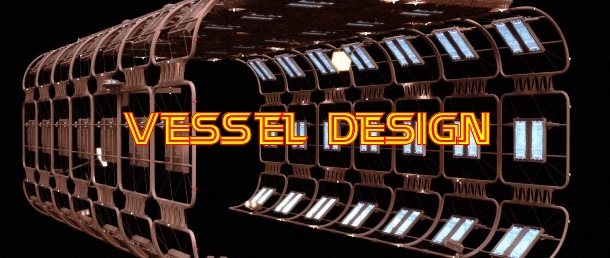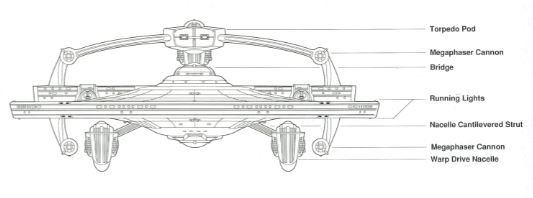
[ Our Name ] [ Starship 101 ] [ Kirov-class ]
[ Adamant-class ] [ Shake-down Trials ] [ Adamant Specs ]
Fictional Design History: Adamant-class Frigate-Dreadnought
STARFLEET is responsible for the protection and exploration of the vast reaches of known and unknown space. Although the Federation is founded on peace, it has learned that a wide variety of both peacetime and military vessels are required to protect and support the Federation.
OUR NAME
The chapters in STARFLEET, the International Star Trek Fan Association, are represented as physical ships with a Commanding Officer, First/Executive Officer, Officers, crewmembers, departments, etc, much like the “real” STARFLEET as seen on television. The chapters themselves chose a specific “ship” or chapter name to distinguish them from the other chapters in the organization. This name is also associated with a ship class, design and registry.
The members of this chapter have chosen to identify themselves with the ship known as the USS Adamant, registry NCC-3029, from the later half of the 23rd century [@ Star Trek V, VI movie era]. The name “adamant” means diamond like, hard and unyielding. We believe that this a suitable name for this chapter since it has endured much adversity in its infancy and yet remains solid.

The USS Adamant’s ship configuration is unique. It is a Frigate-Dreadnought (DNF). The DNF 3029 was the first of five Adamant class to be refitted from the Avenger class, and therefore it is the flagship for the class, and shares its (ship) name with the class name.
THE FEDERATION STARSHIP 101
The Frigate
Frigates are easily identified by their lack of a secondary hull. Their primary hull is essentially a built-up saucer with attached warp nacelles. Frigates are used to transport troops and fighters to areas in conflict such as the Neutral Zone border. The Frigate is primarily used for planetary assault and fleet support operations. When military action is not required, the vessels are used for support missions throughout the Federation. Various versions are designed to meet specific missions.
The Dreadnought
The Dreadnought is a swift and very powerful starship. The addition of a third warp nacelle gives the craft outstanding acceleration, top speed and firepower. The immense starship is capable of massive destruction and is often used to display a show of force in troubled areas. The Dreadnought is equipped with extremely powerful shields and sensors as well as extensive systems to evade detection. This vessel can take quite a beating. During military operations, the Dreadnought is used as a point assault ship and for main-line defense.
The Frigate-Dreadnought
The Frigate-Dreadnought design was an attempt to enhance the best aspects of the Frigate design by adding a third warp nacelle, and thereby turning it into a Dreadnought. This was not an easy task as the Dreadnought design has always been difficult for starship engineers. The very concept is self-contradictory.
A Dreadnought must by definition incorporate all the resources worthy of the name (overwhelming fire-power, large hanger facilities), but at the same time is expected to be one of the fastest ships in the fleet. Speed is usually acquired in a starship by two methods: adding another nacelle (which drastically increases fuel consumption), and trimming excess mass. The latter is not an avenue open to Dreadnought design. For this reason Dreadnought design prototype releases are few and far between.
The Predecessor: Kirov-class
The first Frigate-Dreadnought design was not entirely successful. The ADREFT Kirov (DNF 2150) class Frigate-Dreadnought consisted of modifying an Avenger (FH 1860) class Heavy Frigate type hull by adding a third warp nacelle, supported by a strut between the two standard nacelles. In attaching a third warp drive nacelle to an Avenger’s extended hull, the designers had hoped to mate the large hanger facilities, fearsome fire-power, and high maneuverability of the Heavy Frigate with the speed capability of a Dreadnought. However, the disappointing performance of this design illustrated the problem facing starship designers.
The extra nacelle taxed the main reactor at Flank+ speeds. Furthermore the additional support systems and auxiliary equipment necessary for the third nacelle (extra internal bracings and frames, energy conduits, etc) took up a large fraction of valuable cargo bay space (just ahead of the impulse drive in the Avenger class). There was also a reduction in research facilities, cargo space, fighters, and in the vessel’s acceleration due to the loss of valuable space. In addition, the famous Frigate maneuverability was severely retarded.
A total of five vessels were built before it was found that the design was not satisfactory. The ADREFT concept was eventually shelved in 2289, and no further vessels from the Avenger class were refitted to this design.
THE ADAMANT-CLASS

The problems encountered with the ADREFT Kirov class were solved in its successor, the Adamant class, which uses a small secondary hull to mount the warp engines. Normally the addition of a “secondary hull” would upgrade the classification from Frigate to Cruiser, but the hull is so small that this was not thought appropriate.
This new configuration attached a separate reactor hull aft of the extended hull and moved the impulse drive farther back. The modification of moving the warp systems to the secondary hull cleared up a large amount of space in the primary hull. This allowed for ample space for the nacelle support systems without cannibalizing areas of the primary hull.
As its name suggests, the reactor hull contains only the matter/antimatter reactor (the KR13-O first developed for the Menahga (CG 3100) class Battlecruiser), a horizontal intermix chamber leading forward to the impulse drive, and lateral energy conduits branching-off the intermix chamber to the three warp drive nacelles. Unlike the reactor hulls of the Menahga class Battlecruiser and Thruxton (CT 2761) class TacCruiser, this does not incorporate thrusters or an Engineering Room. Main Engineering is located forward of the hull separation line, surrounding the impulse drive vertical energy conduit.
Hangar space was increased by displacing the impulse drive farther aft – allowing the port and starboard hangars to connect via a transverse parking bay located in the space vacated. The cargo bay is located forward of this. Due to the added hangar space, the ship can carry more fighters than the original Avenger class Frigate. Landing platforms were not utilized in this class. Although they would have freed even more hangar parking space, they would have interfered with the warp dynamics of the ship, being located between three warp drive nacelles.
Like a standard Avenger, the ship has a (roll) bar above the primary hull that mounts the megaphaser cannons and the photon torpedo-launching pod. Relocating the warp nacelles onto the reactor hull allows the ship to mount two additional megaphaser cannons below the primary hull, suspended from the same struts, mirroring the two on the top of the hull. This modification effectively doubles the firepower of a standard Avenger class Frigate to four megaphaser cannons.
The Avenger class’ megaphaser fire-arc “shadow” problem (it can not fire at a target located at its Z axis) was also eliminated by mirroring the top pair of cannon with a lower pair, giving the cannon true double 360 degree coverage. Due to energy limitations, only one pair of cannon can be energized at a time. The megaphaser cannons fire both forward and aft and when the cannons are combined, they can cut through the shields of most ships and destroy their target in just a few hits.
To support these megaphaser cannons, the ship carries eight banks of standard phasers, with six banks located on the primary hull (three on top, three on bottom) and two banks located on the reactor hull.
The torpedo launchers had to be modified from the original Avenger launchers. The launchers that fire aft had to be modified so the torpedoes would leave the launchers at a slight angle to avoid the middle nacelle. The software for the torpedoes was also slightly modified so the drives do not activate until the torpedoes are outside where they are a danger to the warp nacelle.
This ship carries a good sized contingent of marines and carries more fighters than most ships of her size and is often operated as a light carrier as well as a heavy combatant.
SHAKE-DOWN TRIALS
Performance during trial run was excellent. During the all-out speed runs, the Adamant (DNF 3029) came close to matching the emergency maximum velocity of the Ascension (DN 2520) class Dreadnought (a remarkable achievement considering the much greater mass of the Ascension class). Maneuvering was ideal for the Adamant (DNF 3029), besting the Ascension class and nearly as good as the Avenger class.
Ordnance was tested at the Darkstar wargames played out at Starbase 14 in 2293. The Adamant class was the clear overall winner. However it came in third with regards to concerted, maintained precision attack (first was Thruxton, followed by Starstalker).
USS ADAMANT SPECIFICATIONS

| Vessel Specifications: | |
| Prototype Name: | USS Adamant |
| Naval Construction Contract: | NCC-3029 |
| Series: | Class 1b Starship |
| Design: | Frigate |
| Type: | Dreadnought (DNF) |
| Commissioned: | 2291 |
Crew Complement |
85 Officers 345 Enlisted Crewmen 120 Marines 80 Fighter & Shuttle pilots 40 Passengers |
| Dimensions: | |
| Overall Length: | 339.3 m/1114.0 ft |
| Overall Draft (height): | 57.1 m/187.5 ft |
| Overall Beam (width): | 141.7 m/465.2 ft |
| Displacement: | 255,000 metric tons |
| Duration: | |
| Standard: | 5 years |
| Maximum: | 20 years |
| Propulsion Systems: | |
| Impulse: | |
| Weapons: | |
| Phaser Beams | 8 Banks, 2 each |
| Megaphaser Cannons | 4 |
| Photon Torpedos | 2 Bays, 2 each |
| Performance Characteristics (Static): | |
| Warp Dynamic Efficiency: | |
| Power Coefficient Indice | 1.306 |
| Powerplant: | |
| Maximum Output | 2.4 x 1015 |
| Optimum Output | 1.9 x 1015 |
| Subspace Field: | |
| Field Strength | 3.8 x 108 |
| Field Threshold | 1.58 x 1010 |
| Field Persistence | 9.3 |
| Field Radius | 473.0 |
| Field Capacity | 298,000 |
| Performance Characteristics (Dynamic): | |
| Structural Strain Parameters: | |
| Differential Stress (Prime) | 1.72 x 107 |
| Differential Stress (Beta) | 4.21 x 106 |
| Differential Stress (Gamma) | 3.1 x 106 |
| Differential Stress (Delta) | 1.56 x 106 |
| Warpspeed Handling: | |
| Warp Acceleration Rate | 3.5 |
| Warp Deceleration Rate | 2.6 |
| Warp Attitude Change Rate | 0.365 |
| Sublight Handling: | |
| Impulse Acceleration Rate | 4.98 |
| Impulse Deceleration Rate | 6.77 |
| Impulse Attitude Change Rate | 0.199 |
| Speed Performance: | |
| Cruising Speed | wf 8.3 |
| Flank Speed | wf 9.6 |
| Emergency Maximum Speed | wf 12.6 |
Source: Starfleet Prototype: The Journal of Innovative Design and Ideas, Issue 25: 2291-2292 and other sources.


